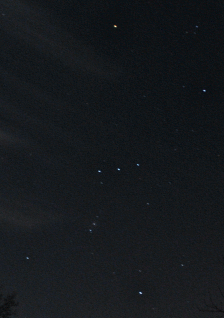Astronomy
Astronomy is the study and graphing/plotting of skyward objects such as stars, planets and other object that are found in our heavens. Astronomy also is important for timekeeping and global positioning when all electronics fail. Since the earth is a sphere rotating around a star and itself spinning, simple geometry can help figure out ones position globally. If you're interested in Astronomy, you may or may not have an interest in Satellites.
Light pollution
Urban lights pollute the night sky which is extremely unfortunate.
Campaign to darken the UK skies
Polaris, the North Star
When you live in the northern hemisphere you most likely know what the big dipper looks like. Not far from the big dipper at 5 times its length in the sky is Polaris, the north star. It may not be seen from the southern hemisphere. If you need some aid in finding the north star take a look at the flag of the state of Alaska, it is a scaled distance of the relationship of the Big Dipper to Polaris. Polaris will always show north and its elevation from the horizon in degrees indicates your latitude as well (best seen near equinoxes).
Also as you watch the night sky as the earth rotates on its own axis it will appear that everything rotates around Polaris. When it is said that Polaris shows north it is the geographic north not the magnetic which is just west of Alert, Nunavut (Canada).
Summer/Winter Solstice
The Solstice indicates an extreme point in the elevation of the sun relative to the viewing horizon. The earth is tilted 23.45 degrees and the tilt is fixed into a certain direction in space. As we complete an orbit around the sun the sun at high noon will appear to shift higher and lower. The highest point is called the summer solstice and the lowest point the winter solstice. It is vice versa south of the equator (australia for example). June solstice is usually on June 23rd and December Solstice is usually on December 20th.
Yes you guessed it. Because of this tilt we have seasons, wherever the sun is highest in the sky is where summer is and the other winter. Equatorial regions have very little differences between summer and winter but the sun travels even here. Solstice on polar regions means either 24 hour daylight or 24 hour night depending on which pole you're on. See equinox for the time when you'll have sunrise/sunset.
Vernal and Autumnal Equinox
The point in time when the tilt of the earth is at a 90 degree angle with the sun and the sun is exactly above the equator at a 90 degree angle is called an equinox. At high noon at the highest sun peak of the day the sun should be at exactly south. This is also the median of the day between sunrise and sunset. Photographing the sun for a year every day and showing the path of the sun is called an analemma and where the path of sun crosses itself is where the equinoxes cross. Vernal Equinox is on March 20th, and Autumnal Equinox is on September 23rd.
Asterisms
An asterism is a pattern of stars in the night sky which aren't an official constellation.
- Big Dipper
- Winter Hexagon
- Summer Triangle
The above are a few asterisms known.
Orion the Hunter
Orion is seen in the winter sky usually in the southern sky. It's distinctive "Orion's belt" is three stars in series and is a good marker to find constellations and stars in the winters night sky.

